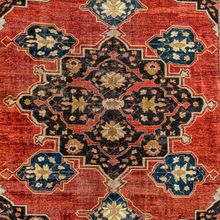Arak Rug
| Arak Rug | |
|---|---|
 Design of Arak Rug (Rugman) | |
| General information | |
| Name | Arak Rug |
| Original name | قالی اراک |
| Alternative name(s) | Arak Carpet (Sultan Abad) |
| Origin | |
| Category | City |
| Technical information | |
| Common designs | Herati (Fish), Lachak Toranj |
| Common colors | Crimson, Red, Navy Blue, Green, Cream, Beige, Blue |
| Dyeing method | Natural, Synthetic |
| Pile material | Wool, Silk |
| Foundation material | Cotton |
| Knot type | Asymmetrical (Persian) |
Arak Rugs originate from Arak, previously known as Sultanabad, is the capital city in the Province of Markazi, located in west central Iran. A very important region in the making of Persian area rugs, the roots of its commercial rug weaving industry can be traced back to the 17th century. After World War II the Province of Arak became known for a particular style of rug called the Sarouk. These very attractive area rugs, named after a village in the area, typically feature detached floral sprays in an all-over design on a red background. Arak rugs are woven using asymmetrical Persian knots. The quality of the rug is largely dependant on the number of knots per square inch and may vary from rug to rug.
History
Arak, formerly Sultanabad, is a city in west central Iran. Today Arak is the capital city of Arak Province. In this province are several important towns and villages that made carpets and rugs beginning in the mid-nineteenth century, some of which have achieved recognition in the carpet industry worldwide, such as FARAHAN, LILIHAN, MOHAJERAN, MOSHKABAD, SAROUK, and SULTANABAD, among many others.[1]
Materials
Foundation and Pile
Silk pile and silk foundations were frequently used in antique pieces, but rarely seen in new Arak rugs. In general the foundation is cotton, but on occasion goat hair is used. The wool of the area rugs is hand spun, usually from the weaver's own sheep.
Techniques and structures
Color and dyeing
Arak rugs are predominantly red and navy blue, while green and ivory are prominently used as well.
Motifs and Designs
In the 1920s weavers in this region transitioned away from their traditional designs to those more attuned to the American market.[2]
Arak rugs usually feature one of three major patterns. The most well known is the Herati, featuring small fish throughout the field, with or without a central medallion. The Sarough is a more curvilinear pattern of intertwined grapevines throughout the field and a round central medallion. The pattern known as Wiss is comprised of three diamonds that make up the central medallion.
Weaving techniques
Arak rugs are woven using asymmetrical Persian knots.
By the late twentieth century many Arak Province weavers made carpets similar to those from other provincial cities and villages in accordance with the der foreign and domestic consumers.[3]
See also
Ferahan Rug, Lilihan Rug, Mohajeran Rug, MoshkAbad Rug, Sarouk Rug, Sultanabad Rug
References
Bibliography
- Abraham Levi Moheban, (2015), The Encyclopedia of Antique Carpets: Twenty-Five Centuries of Weaving, NewYork: Princeton Architectural Press.
- Nazmiyal Antique Rugs, (2019).
- Ehsan Afzalzadeh Naini, (2005), Arak Carpets, JOZAN: Rug news and antique rugs.
- JOZAN: Rug news and antique rugs.